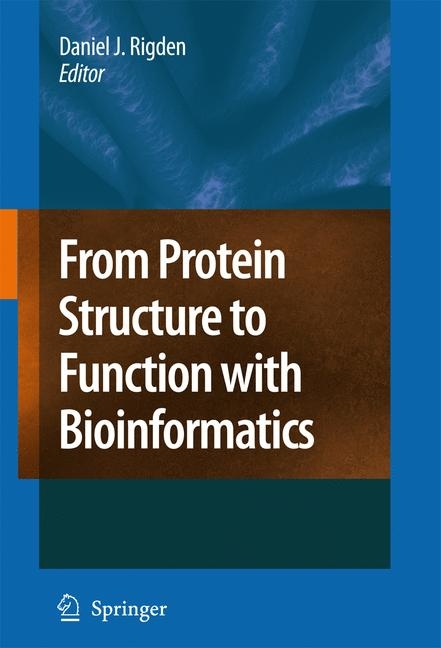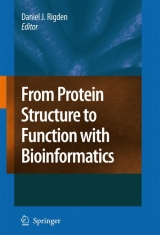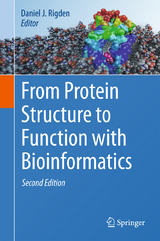From Protein Structure to Function with Bioinformatics
Springer-Verlag New York Inc.
978-1-4020-9057-8 (ISBN)
- Titel erscheint in neuer Auflage
- Artikel merken
Proteins lie at the heart of almost all biological processes and have an incredibly wide range of activities. Central to the function of all proteins is their ability to adopt, stably or sometimes transiently, structures that allow for interaction with other molecules. An understanding of a protein's structure can therefore lead us to a much improved picture of its molecular function(s). This realisation has been a prime motivation of recent Structural Genomics projects, involving large-scale experimental determination of protein structures, often those of proteins about which little is known of function. These initiatives have, in turn, stimulated the massive development of novel methods for prediction of protein function from structure.Since model structures may also take advantage of new function prediction algorithms, the first part of the book deals with the various ways in which protein structures may be predicted or inferred, including specific treatment of membrane and intrinsically disordered proteins.
A detailed consideration of all current structure-based function prediction methodologies forms the second part of this book, which concludes with two chapters, focusing specifically on case studies, designed to illustrate the real-world application of these methods. With bang up-to-date texts from world experts, and abundant links to publicly available resources, this book will be invaluable to anyone who studies proteins and the endlessly fascinating relationship between their structure and function.
Table of Contents Part 1: Generating and inferring structures 1 Ab initio protein structure prediction 1.1 Introduction 1.2 Energy functions 1.2.1 Physics-based energy functions 1.2.2 Knowledge-based energy function combined with fragments 1.3 Conformational search methods 1.3.1 Monte Carlo simulations 1.3.2 Molecular dynamics 1.3.3 Genetic algorithm 1.3.4 Mathematical optimization 1.4 Model selection 1.4.1 Physics-based energy function 1.4.2 Knowledge-based energy function 1.4.3 Sequence-structure compatibility function 1.4.4 Clustering of decoy structure 1.5 Remarks and discussion 2 Fold Recognition 2.1 Introduction 2.1.1 The importance of blind trials: the CASP competition 2.1.2 Ab initio structure prediction versus homology modelling 2.1.3 The limits of fold space 2.1.4 A note on terminology: 'threading' and 'fold recognition' 2.2 Threading 2.2.1 Knowledge-based potentials 2.2.2 Finding an alignment 2.2.3 Heuristics for alignment 2.3 Remote homology detection without threading 2.3.1 Using predicted structural features 2.3.2 Sequence profiles and hidden Markov models 2.3.3 Fold Classification and Support Vector Machines 2.3.4 Consensus approaches 2.3.5 Traversing the homology network 2.4 Alignment accuracy, model quality and statistical significance 2.4.1 Algorithms for alignment generation and assessment 2.4.2 Estimation of statistical significance 2.5 Tools for fold recognition on the web 2.6 The future 3 Comparative protein structure modelling 3.1 Introduction 3.1.1 Structure determines function 3.1.2 Sequences, structures, structural genomics 3.1.3 Approaches to protein structure prediction 3.2 Steps in comparative protein structure modelling 3.2.1 Searching for structures related to the target sequence 3.2.2 Selecting templates 3.2.3 Sequence to structure alignment 3.2.4 Modelbuilding 3.2.5 Model evaluation 3.3 Performance of comparative modelling 3.3.1 Accuracy of methods 3.3.2 Errors in comparative models 3.4 Applications of comparative modelling 3.4.1 Modelling of individual proteins 3.4.2 Comparative modelling and the Protein Structure Initiative 3.5 Summary 4 Membrane protein structure prediction 4.1 Introduction 4.2 Structural classes 4.2.1 Alpha-helical bundles 4.2.2 Beta-barrels 4.3 Membrane proteins are difficult to crystallise 4.4 Databases 4.5 Multiple sequence alignments 4.6 Transmembrane protein topology prediction 4.6.1 Alpha-helical proteins 4.6.2 Beta-barrel proteins 4.6.3 Whole genome analysis 4.6.4 Data sets, homology, accuracy and cross-validation 4.7 3D structure prediction 4.8 Future developments 5 Bioinformatics approaches to the structure and function of intrinsically disordered proteins 5.1 The concept of protein disorder 5.2 Sequence features of IDPs 5.2.1 The unusual amino acid composition of IDPs 5.2.2 Sequence patterns of IDPs 5.2.3 Low sequence complexity and disorder 5.3 Prediction of disorder 5.3.1 Prediction of low-complexity regions 5.3.2 Charge-hydropathy plot 5.3.3 Propensity-based predictors 5.3.4 Predictors based on the lack of secondary structure 5.3.5 Machine learning algorithms 5.3.6 Prediction based on contact potentials 5.3.7 A reduced alphabet suffices to predict disorder 5.3.8 Comparison of disorder prediction methods 5.4 Functional classification of IDPs 5.4.1 Gene Ontology-based functional classification of IDPs 5.4.2 Classification of IDPs based on their mechanism of action 5.4.3 Function-related structural elements in IDPs 5.5 Prediction of the function of IDPs 5.5.1 Correlation of disorder pattern and function 5.5.2 Predicting short recognition motifs in IDRs 5.5.3 Prediction of MoRFs 5.5.4 Combination of information on sequence and disorder:
| Erscheint lt. Verlag | 12.12.2008 |
|---|---|
| Zusatzinfo | biography |
| Verlagsort | New York, NY |
| Sprache | englisch |
| Maße | 155 x 235 mm |
| Gewicht | 678 g |
| Themenwelt | Medizin / Pharmazie ► Studium |
| Naturwissenschaften ► Biologie ► Biochemie | |
| Naturwissenschaften ► Biologie ► Mikrobiologie / Immunologie | |
| ISBN-10 | 1-4020-9057-9 / 1402090579 |
| ISBN-13 | 978-1-4020-9057-8 / 9781402090578 |
| Zustand | Neuware |
| Haben Sie eine Frage zum Produkt? |
aus dem Bereich





